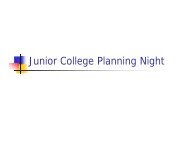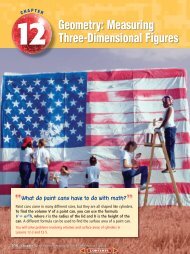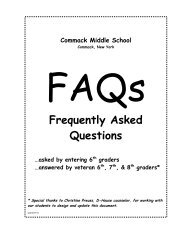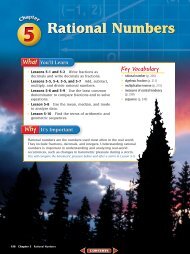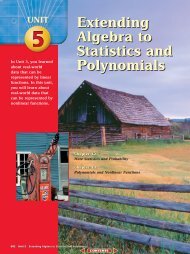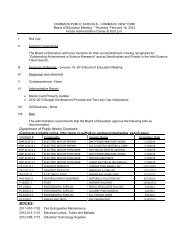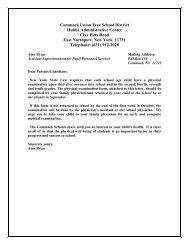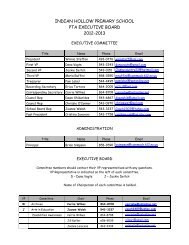Preparing for the Regents Examination Geometry, AK
Preparing for the Regents Examination Geometry, AK
Preparing for the Regents Examination Geometry, AK
Create successful ePaper yourself
Turn your PDF publications into a flip-book with our unique Google optimized e-Paper software.
Note: Since <strong>the</strong>re are many variations of proofs,<br />
<strong>the</strong> following is simply one set of acceptable<br />
statements to complete each proof. Depending<br />
on <strong>the</strong> textbook used, <strong>the</strong> wording and <strong>for</strong>mat<br />
of reasons may differ, so <strong>the</strong>y have not been<br />
supplied <strong>for</strong> <strong>the</strong> method of congruence applied<br />
in each problem. (These solutions are intended<br />
to be used as a guide—o<strong>the</strong>r possible solutions<br />
may vary.)<br />
5 1. ABCD is an isosceles trapezoid.<br />
2. BAD CDA<br />
3. −−<br />
BC −−−<br />
AD<br />
4. NBC BAD<br />
5. NCB CDA<br />
(Corresponding<br />
angles are<br />
congruent.)<br />
6. NBC NCB (Substitution<br />
postulate)<br />
7. NBC is isosceles. (Base angles of an<br />
isosceles triangle<br />
are congruent.)<br />
6 1. Isosceles trapezoid ABCD<br />
2. −−<br />
AB −−−<br />
DC<br />
3. BAD CDA (Base angles of an<br />
isosceles trapezoid<br />
4.<br />
are congruent.)<br />
−−−<br />
AD −−−<br />
AD<br />
5. ADB DAC<br />
7 1. Trapezoid ABCE<br />
2.<br />
(SAS SAS)<br />
−−<br />
BD −−−<br />
AD<br />
3. −−<br />
AB −−<br />
CE<br />
4. A B<br />
5. CED A<br />
6. ECD B (Corresponding<br />
angles are<br />
congruent.)<br />
7. CED ECD (Substitution<br />
8.<br />
postulate)<br />
−−−<br />
CD −−<br />
ED<br />
9. −−<br />
BD −−−<br />
CD ( Subtraction<br />
−−−<br />
AD −−<br />
ED<br />
10.<br />
postulate)<br />
−−<br />
BC −−<br />
AE<br />
11. ABCE is an (Nonparallel sides<br />
isosceles trapezoid. of an isosceles<br />
trapezoid are<br />
congruent.)<br />
8 1. Quadrilateral PQRS<br />
2. −−−<br />
QAB , −−−<br />
RAS , and −−−<br />
PSB<br />
3. −−<br />
QB bisects −−<br />
RS .<br />
4. −−<br />
RA −−<br />
AS<br />
64 Chapter 10: Quadrilaterals<br />
5. −−−<br />
PSB −−−<br />
QR<br />
6. RAQ BAS (Vertical angles are<br />
congruent.)<br />
7. QRA BSA (Alternate interior<br />
angles are<br />
congruent.)<br />
8. QRA BSA<br />
9.<br />
(ASA ASA)<br />
−−−<br />
QA −−<br />
AB<br />
9 1. Isosceles trapezoid ABCD<br />
2. A D<br />
3. −−−<br />
AD −−<br />
BC<br />
4. −−<br />
AB −−−<br />
DC<br />
5. E is <strong>the</strong> midpoint of −−−<br />
AD .<br />
6. −−<br />
AE −−<br />
ED<br />
7. ABE DCE<br />
8. a<br />
(SAS SAS)<br />
−−<br />
BE −−<br />
CE<br />
9. BE CE<br />
(CPCTC)<br />
10. BCE is isosceles. (Definition of isos-<br />
11. b<br />
celes triangle)<br />
−−<br />
EH −−<br />
BC (The median from<br />
<strong>the</strong> vertex angle of<br />
an isosceles triangle<br />
is perpendicular<br />
to <strong>the</strong> base.)<br />
10 1. Isosceles trapezoid PQRS<br />
2. −−<br />
PQ −−<br />
RS<br />
3. −−−<br />
QR −−<br />
PS<br />
4. P S<br />
5. −−<br />
PS −−<br />
PS<br />
6. PQS SRP (SAS SAS)<br />
7. PQS SRP (CPCTC)<br />
8. QAP BAS (Vertical angles are<br />
congruent.)<br />
9. PAQ SAR<br />
11 1. Trapezoid ABCD<br />
2.<br />
(AAS AAS)<br />
−−<br />
BR −−−<br />
AD<br />
3. −−−<br />
CM −−−<br />
AD<br />
4. ARB and DMC are right angles.<br />
5. ARB and DMC are right triangles.<br />
6. −−<br />
AB −−−<br />
CD<br />
7. BAR CDM<br />
8. ARB DMC (Hypotenuse–acute<br />
angle)<br />
9. 1 2 (CPCTC)<br />
12 1. Trapezoid PQRS<br />
2. Q R<br />
3. −−<br />
PA −−−<br />
QR , −−<br />
SE −−−<br />
QR<br />
4. PAQ and SER are right angles.<br />
5. PAQ and SER are right triangles.




